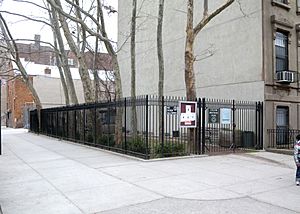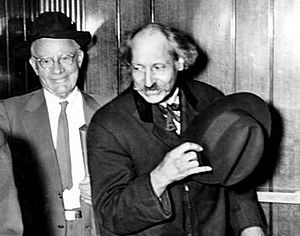Collyer brothers facts for kids
Quick facts for kids
Homer Collyer
|
|
|---|---|
| Born |
Homer Lusk Collyer
November 6, 1881 |
| Died | March 21, 1947 (aged 65) |
| Cause of death | Died due to health issues |
| Resting place | Cypress Hills Cemetery, Brooklyn |
| Nationality | American |
| Education | PS 69 |
| Alma mater | College of the City of New York Columbia University |
| Occupation | Lawyer |
| Collyer Brothers Park | |
|---|---|
 |
|
| Type | Pocket Park |
| Location | 2078 Fifth Avenue |
| Nearest city | New York, New York |
| Area | 1,500 square feet (140 m2) |
Homer Lusk Collyer (born November 6, 1881, died March 21, 1947) and Langley Wakeman Collyer (born October 3, 1885, died around March 9, 1947) were two American brothers. They became well-known for their unusual lives and for collecting a huge amount of items. This is also known as compulsive hoarding.
For many years, the brothers lived alone in their home in Harlem, New York City. They filled their house with books, furniture, musical instruments, and countless other things. They even created piles of items that could easily fall over, making it hard to move around. Both brothers died in their home in March 1947. They were found surrounded by more than 140 tons of items they had collected over decades.
Today, the spot where their house once stood is a small public space. It is called the Collyer Brothers Park, named in their memory.
Contents
The Collyer House: A Mountain of Stuff
When police and workers finally entered the Collyer brothers' house, they found an incredible amount of items. They removed about 120 tons of things. Imagine a house filled from floor to ceiling!
What Was Found Inside?
The items included old baby carriages, rusty bicycles, and even old food. There were also many valuable things like glass chandeliers and a collection of guns. They found more than 25,000 books, including many about medicine and engineering.
Other strange finds were fourteen pianos, two organs, and many other musical instruments. There were also hundreds of yards of unused fabrics, old clocks, and countless bundles of newspapers. They even found parts of an old Model T car.
Near where Homer Collyer died, police discovered 34 bank account books. These accounts held a total of $3,007. This amount would be worth much more today.
The House's Condition
The house itself was falling apart. The roof leaked, and some walls had collapsed. Bricks and mortar had fallen into the rooms below. In July 1947, the house was declared unsafe and a fire risk. It was torn down later that month.
Most of the items found were considered worthless and were thrown away. The few valuable items were sold at an auction for about $2,000. The brothers' total estate, including money and jewelry, was valued at $91,000. Many relatives tried to claim the money. In 1952, a court decided that 23 relatives would share the estate.
The Collyer Brothers in Pop Culture
The story of the Collyer brothers has inspired many books, TV shows, and plays. Their unique way of life made a lasting impression.
Inspired Stories and Terms
- The term "Collyer's Mansion" is now used by firefighters. It describes a home filled with so much stuff that it becomes dangerous for the people living there and for emergency responders.
- The author Marcia Davenport wrote a novel called My Brother's Keeper in 1954. It was one of the first stories directly inspired by the brothers.
- In a 1955 episode of The Honeymooners, a TV show, the character Ed Norton jokingly mentions the Collyer brothers. He talks about their very low gas bill, hinting at their unusual lifestyle.
- The 1995 movie Unstrung Heroes features two uncles who live in a way very similar to the Collyer brothers. The film was based on a memoir by Franz Lidz, who later wrote a book about the brothers called Ghosty Men.
- In 2009, E. L. Doctorow published Homer & Langley. This novel is a fictional story about the brothers' lives, imagining what they might have been like.
- The brothers also inspired a play called The Dazzle. It was performed in London and received good reviews.
- An episode of the TV show 9-1-1 called "Trapped" was also inspired by the Collyer brothers. It showed two brothers trapped in their home, which was full of items.
See also
 In Spanish: Hermanos Collyer para niños
In Spanish: Hermanos Collyer para niños


